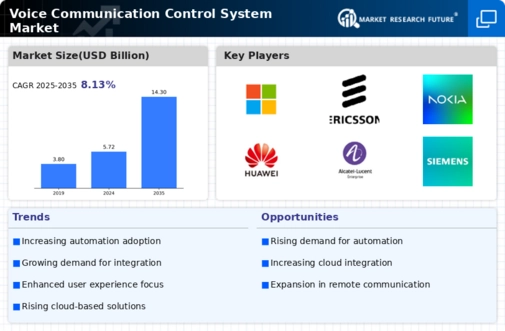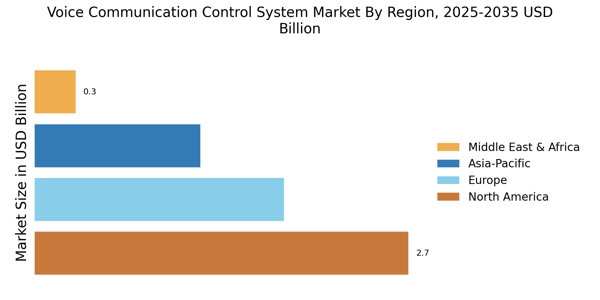Regulatory Compliance and Security Concerns
Regulatory compliance and security concerns are increasingly influencing the Voice Communication Control System Market. Organizations are under pressure to adhere to stringent regulations regarding data protection and privacy, particularly in sectors such as finance and healthcare. This has led to a heightened demand for communication systems that not only comply with these regulations but also offer robust security features. Recent reports indicate that the market for secure communication solutions is expected to grow by over 10% in the coming years, as businesses prioritize the protection of sensitive information. As a result, the Voice Communication Control System Market is evolving to incorporate advanced security measures, ensuring that organizations can communicate effectively while safeguarding their data.
Advancements in Voice Recognition Technology
Advancements in voice recognition technology are playing a pivotal role in shaping the Voice Communication Control System Market. The integration of sophisticated algorithms and machine learning techniques has led to enhanced accuracy and reliability in voice communication systems. This technological evolution is particularly beneficial in sectors such as customer service and security, where precise voice recognition can streamline operations and improve user experience. Recent studies indicate that the voice recognition segment within the market is expected to witness substantial growth, potentially reaching a valuation of over 5 billion dollars by 2026. As organizations increasingly adopt these advanced systems, the Voice Communication Control System Market is poised for significant transformation, driven by the demand for innovative communication solutions.
Increased Focus on Remote Communication Solutions
The shift towards remote work and virtual collaboration has catalyzed growth in the Voice Communication Control System Market. As organizations adapt to new working environments, the need for reliable remote communication tools has become paramount. This trend is particularly pronounced in sectors such as education and corporate training, where effective communication is essential for maintaining engagement and productivity. Market analysis suggests that the demand for remote communication solutions is expected to rise by approximately 15% annually, reflecting the ongoing transition to hybrid work models. Consequently, the Voice Communication Control System Market is likely to see an influx of innovative solutions designed to facilitate seamless communication across dispersed teams.
Rising Demand for Efficient Communication Solutions
The Voice Communication Control System Market is experiencing a notable surge in demand for efficient communication solutions across various sectors. Organizations are increasingly recognizing the necessity for streamlined communication to enhance operational efficiency and productivity. This trend is particularly evident in industries such as healthcare, aviation, and emergency services, where timely and clear communication is critical. According to recent data, the market is projected to grow at a compound annual growth rate of approximately 12% over the next five years. This growth is driven by the need for systems that can facilitate real-time communication, thereby reducing response times and improving overall service delivery. As businesses continue to prioritize effective communication strategies, the Voice Communication Control System Market is likely to expand significantly.
Integration of Multi-Channel Communication Platforms
The integration of multi-channel communication platforms is emerging as a key driver in the Voice Communication Control System Market. Organizations are increasingly seeking solutions that allow for seamless communication across various channels, including voice, video, and messaging. This trend is particularly relevant in customer service and support sectors, where providing a cohesive experience across different platforms is essential for customer satisfaction. Market forecasts suggest that the demand for integrated communication solutions will grow significantly, with an expected increase of around 20% in the next few years. As businesses strive to enhance customer engagement and streamline operations, the Voice Communication Control System Market is likely to witness a surge in the development of multi-channel solutions.


















Leave a Comment